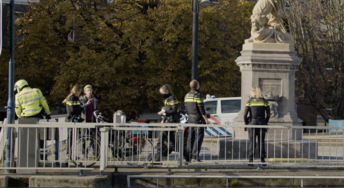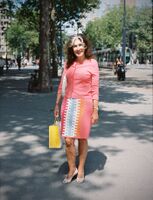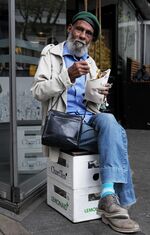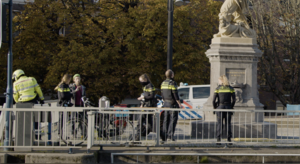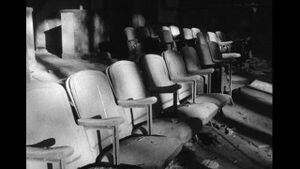Text on practice s.c.p.k
V04
I do not know about the things I want to know. My practice is focused on learning, understanding and (hopefully) knowing. This pursuit exists in a collaborative sphere where I work with the craft of filmmaking- and attempt to stretch beyond it to listen and live with the emotions, thoughts, actions and phenomena of humans around me. Not knowing does not have to mean I am ignorant. Therefore, I make to know.
Currently, I am working on a project titled Dear Moritz, using a hybrid form of documentary, fiction and film essay. It presents an encounter that I witnessed and captured in public space. The day I shot the film, I was waiting for a friend. We had planned to film something else, in his neighbourhood, but he was late. I was at our meeting point, which was near a square with one of the last colonial figure-sculptures in the city. While waiting, I decided to build up my camera setup and begin filming some environment B-roll. Suddenly, some commotion started between people standing at the sculpture. These people became the subjects, participants in my film: a civilian artist, police officers, my friend and eventually, myself. The artist was working on a (non destructive) intervention with the statue. The police quickly showed up and there was confrontation. There were brief moments of tension between the parties. Eventually, my friend of Cape Verdian and Surinamese descent showed up. He presented a different sort of attitude toward dealing with the sculpture and colonial ideology than the artist and the police. We all shared a sort of common frustration and confusion.
I did not think much of this spontaneous scene at first. I went on with my friend to film the project we had originally planned, but in the following days my mind kept tracking back to the encounter with Moritz. I watched the footage repeatedly for several weeks. Slowly I began to put together my thoughts into words, working on a script to use as a close reading voiceover to the film. The script developed through conversations with the artist, my friend and mentors. It became a way to annotate, think through and highlight certain elements. Complementing the script, I then altered the static visual-nature of the film through digital zooms and editing to stretch the fabric of the long-take shot in providing more than its pixels. The shooting and assembly of my film is a technically autonomous process but ultimately my work is a collaborative process. The artist for example, became a friend who I met with several times. Building trust and relationships is crucial to opening conversation and giving (larger than life) voice through moving images.
Dear Moritz and the work I intend to continue making, straddles the border of fiction & non fiction, unclear as to what is real, or possibly having been preconceived by the maker. Rather than being built off of a script or interview questions, my film is built off of the notion of a ‘holy moment’ (Zahedi, Bazin). The physical world and its social interactions are an engine for my work. This framework is essential to me as it provides a form in which a viewer can also join me in the conversations I have enroute of the pursuit of knowledge.
My background in traditional film production and commercial filmmaking has led me to wrestling between the poles of image making within my practice. Throughout my experiences in these fields, I developed a deep interest in working outside of the clean studio walls. Gradually I began working in a practice dealing with street photography and street cinema, focused on interaction with strangers. This often came in the form of candid interviews and portraits in a documentary style.
I aimed to have the people around me tell a story, their story, instead of writing one for them. This is something I still maintain as important, but my previous practice lacked a voice of authorship. It meandered in immaturity due to a passive approach lacking depth. This is also because I worked under the title of cinematographer or editor- a rich experience, but one of complement to a larger narrative or vision of another maker.
What will follow for me is a continuation of exploration into the world that I encounter and understanding it. I look to continue this approach to working with the candid and capturing public space. I am still wrestling with how to create a reliable methodology based on the unplanned, the spontaneous. A weekly exercise that continues to open possibilities in this lane and nonetheless enjoyable camera-based process is that of making portraits and talking to people in the streets.
I am also continuing to build relationships with people, understanding (their) stories. One example of this is Marty, a man who works at the sex shop under my apartment. After he accepted a package in the mail for me when I was away, we slowly began speaking. This started slowly but led to an almost daily happening. First, a cashier-counter separated us and we spoke for just a few minutes. With time, we were going for lunch together on his break and watching films at the cinema after his shift. Now, I pop down with coffee and we hang out for hours together behind the counter. Marty is an orphan from India raised in the Netherlands and he confided in me a sort of personal creative crisis he feels within himself. We have begun to passively battle this through our meetings, learning each other. Eventually, the camera was worked into this. We film together, often just conversations we have, but also different concepts we are developing to film in the future, revolved around his experiences and his love for creativity, spirituality and cooking. The project is currently floating in a space of uncertainty in regards to a concrete outcome, but serves as constantly developing methodology of speaking with people.
Human thought, spontaneity and interaction is the fuel that my artistic engine runs on. Connection with others is imperative to me, and I want to explore that audio-visually. Connection also leads to conversation, friction, debate, understanding or appreciation. I feel all these things when working as an artist, and I want others to feel with me.
Additionally, I feel the need to challenge myself outside the comfortable confines of for-profit filmmaking. The current age of constant, clickable content is one I find myself contributing to as someone needing to pay bills. In an effort to counter the hyperreality of images, I want to bring thoughtful works into the eyes and minds of participants and viewers.
Through recent and continued reading, research, writing and making, I am understanding better the kinetic energy between these elements and how it can develop a strong structure and methodology for myself as a maker. Being able to see myself and my work outside the parameters of a job or role tied to a specific department or industry has been paramount for me in the recent months. Since beginning at PZi, I have made an effort to watch at least one film per day. This can be any format, genre, length, etc. The goal is to grow my film and video lexicon and be an omnivore in understanding approaches. Regardless of the film, I must give it my attention and an analytical eye. I also try to write (often short, occasionally long) any thoughts I have about the films in a diary. This filmic training helps develop a palette of plurality as a maker. It is through this that I have discovered a deep, rich well of provocative cinema stretching decoloniality, feminism, non-linear and more forms. Makers like Christopher Harris, Chick Strand and Ana Vaz are several that have stimulated particular interest and helped me to understand the non linear approach. In bridging fictional and documentary elements together, recent work by Denis Côté as well as the late legend Abbas Kiarostami are consistent sources of inspiration. With regards to pace and space for viewers as well as sprinkling humour in serious work, the films of Apichatpong Weerasethakul provide endless insight.
I am an artist working with moving images to explore human culture and condition. I am curious about occurrences & interactions, habits, cycles and trends, both individual and collective. Who does what? How does power assert itself within the daily? What are the relationships between people & places? What happened today? And tomorrow? Eager to continue to pursue my research I look forward to exploring these notions through making. At my disposal are the tools of cinema, which I can use to reach beyond cinema and propose new narratives, perspectives and questions in audio-visual conversation.
I do not know. I may not ever know. I will continue to try to learn, while never exchanging a pursuit of truth for simple, perceived fact.
V03
What have you been making?
I am working on a short film titled Dear Moritz. It uses a hybrid form of documentary, fiction and film essay.
The film involves an encounter that I witnessed and captured in public space. I am always looking for spontaneity in public and urban environments. The best spontaneity though, find you. The day I shot the film, I was waiting for a friend. We had planned to film something else in his neighbourhood, but he was late. It was a sunny Sunday in mid-november. I was at our meeting point, which was near a square with one of the last colonial figure-sculptures in the city. While waiting, I decided to build up my camera and begin filming the environment around me. At that moment it was the canal below me, trees and sun-kissed couples enjoying a weekend stroll. Suddenly, some commotion started between people standing at the sculpture. These people became the subjects, participants in my film. A civilian artist, police officers, a friend of mine and eventually, myself. The German artist was working on a (non destructive) intervention with a statue of a Dutch colonial figure. The Dutch police quickly showed up and there was confrontation. There were some brief moments of tension between the parties that did not form into much more. Eventually, my friend of Cape Verdian and Surinamese descent showed up. He presented a different sort of attitude toward dealing with the sculptures than the artist. We all shared a sort of common confusion.
The film presents a moment in public between people, through my understanding of it, through a camera lens, largely one long take, but also fragmented and contemplative. It uses a voiceover track, where I also speak through my thoughts in close reading. The film is presented in a way that also challenges the viewer to understand the ‘real’ whether it is scripted and set-up or not. It explores questions of privilege and power and attempts to open space for the viewer to contemplate how different human beings interact, get by or feel.
How did you do it?
I shot and edited the film myself. My experience with street photography and cinema has provided me with some necessary tools and confidence regarding filming in public. Although I went on to film the original project with my friend that day but in the days after I was hung up on the encounter. I watched the footage repeatedly for weeks. Slowly I began to put together my thoughts into words, working on a script to use as a close reading over the film. The script developed through conversations in the following weeks with the artist, my friend and mentors. It became a way to annotate, think through and highlight certain elements.
Subsequently, I used that as a base to also alter the static visual-nature of the film, through digital zooms and editing to reinforce the voice over and stretch the fabric of the long take shot to provide more than its pixels. The film is authored by me but ultimately a collaborative piece. The civilian I filmed ended up becoming an acquaintance, and after the filming we developed a collegial relationship, something I think is crucial to opening conversations and giving (larger than life) voices to people through moving images.
Relation to previous practice
With my background in traditional film production and commercial filmmaking, I find myself wrestling to open up the poles of image making within my practice. Throughout my experiences in these fields, I developed a deep interest in working outside of the clean studio walls. Gradually I began working in a practice dealing with street photography and street cinema, focused on interaction with strangers. This often came in the form of candid interviews and portraits in a documentary style.
These projects aimed to have the people around me tell a story, their story, instead of writing one for them. This is something I still maintain as important, but my previous practice was also lacking a voice of authorship from myself. It meandered in immaturity due to a passive approach lacking depth. This is also because I worked officially always as a cinematographer, a rich experience, but one of complement to a larger narrative or vision of another maker.
What do you want to make next?
What will follow for me is a future exploration into the world that I encounter and understanding it. I want to build trust and connections with the people and phenomena around me, in a way that continues to engage a viewer through conversation and dynamism in visual language.
In the future I look to continue this candid and open approach to working in and capturing public space. I am still wrestling with how to create a reliable methodology based on the unplanned, the spontaneous. I therefore continue to make portraits and acquaintances in the streets around me. One example of this is with Marty, a man who works at the sex shop under my apartment. After he accepted a package in the mail for me when I was away, we slowly began speaking on an almost daily basis. This started with me behind the counter for a few minutes, to us going out for lunch and watching films to me now coming down with coffee and hanging out for hours together behind the counter of the shop. Marty confided in me a sort of personal and creative crisis he feels within himself. We are meeting to film constantly, often just conversations we have together, his thoughts but also different concepts we are developing revolved around his love for cooking. The project is currently floating in a space of uncertainty in regards to a concrete outcome, but serves as constantly developing research and growth of our relationship and his life.
I am also continuing to work on the project I mentioned, the original plan on the day that Dear Moritz happened. This film is an experimental documentary focusing on a particular building in that neighbourhood. Two years ago the city deemed this apartment building no longer liveable, and relocated the few families still living there. The housing company that manages it has continued to pay the water and electricity bill while free working studios are being provided for young artists (and a few squatters that made their way in). What is happening with this place brings praise and criticism from all sides, especially in a poor neighbourhood that the city is aiming to rejuvenate. Questions of gentrification, privilege and economies of capitalism and socialism surround this project.
Why do you want to make it?
I want to continue making in this manner because interaction is the fuel that my artistic engine runs on. Connection with others is imperative to me, and I want to explore that audio-visually. Connection also leads to conversation, friction, debate, understanding or appreciation. I feel all these things when working as an artist, and I want others to feel with me.
Additionally, I feel the need to challenge myself outside the comfortable confines of for-profit filmmaking. The current age of constant, clickable content is one I find myself contributing to as someone needing to pay bills. In an effort to counter the hyperreality of images, I want to bring thoughtful works into the worlds of others.
Relation to a larger context
I am an artist working with moving images to explore human culture and condition. I am curious about occurrences & interactions, habits, cycles and trends, both individual and collective. Who does what? How does power assert itself within the daily? What are the relationships between people & places? What happened today? Where do we go tomorrow? Concepts that are a focus for me are expanded cinema, the encounter and the politics of image making and representation.
Through recent and continued reading, research, writing and making, I am understanding better the kinetic energy between these elements and how it can develop a strong structure and methodology for myself as a maker. Being able to see myself and my work outside the parameters of a job or role tied to a specific department or industry has been paramount for me in the recent months. Since beginning at PZi, I have made an effort to watch at least one film per day. This can be any format, genre, length, etc. The goal is to grow my film and video lexicon and be an omnivore in understanding approaches. Regardless of the film, I must give it my attention and an analytical eye. I also try to write (often short, occasionally long) any thoughts I have about the films in a diary. I see this as a sort of subconscious exercise in plurality as a maker.
Since beginning the program at PZI, I have challenged myself to try to watch at least one film per day. Short, mid or full, length- regardless, I must give it my attention, and attempt to think critically or analytically on it, sometimes writing a few lines or a short text of my thoughts. It is through this that I have discovered a deep, rich well of provocative cinema stretching decoloniality, feminism, non-linear and more forms. Makers like Christopher Harris, Chick Strand and Ana Vaz are several that have stimulated particular interest and helped me to understand the non linear approach. In bridging fictional and documentary elements together, recent work by Denis Côté as well as the late legend Abbas Kiarostami continue to fuel the motor of which I intend to run on. Films by Apichatpong Weerasethakul seem to make a certain bridge between these different types of film that I very much appreciate. Ultimately, it provides a pace that I hope to emulate. I suppose slow is how most would describe it.
With regards to literature, concepts of note that I am focusing on now are expanded cinema, the encounter and the politics of image making and representation. One text I have come across thanks to a teacher- An Attempt at Exhausting a Day in Paris (Georges Perec) provides a writing style that intrigues me in terms of translating this to a visual quality. Observational and hyper-detailed yet relaxed and sprinkled with humour and absurdity. In some ways, Dear Moritz is an attempt (no pun intended) at doing the same.
I am eager to continue to pursue research and explore through making. Using the tools of cinema to reach beyond it and propose new narratives, perspectives and questions in audio-visual conversation.
References
Gilles Deleuze - the moment and encounter https://www.euppublishing.com/doi/abs/10.3366/dls.2014.0143 https://www.pomoculture.org/2020/07/02/the-art-of-the-encounter/
Expanded Cinema - Gene Youngblood
http://www.faculty.umb.edu/gary_zabel/Phillosophy_of_Cinema/Syllabus.html
Maya deren
https://pzwiki.wdka.nl/mediadesign/Illuminating_Lucifer_(Carel_Rowe)
Kenneth anger
V02
What have you been making?
I am an artist working with moving images to explore human culture and condition. With my background in traditional film production and commercial filmmaking, I find myself wrestling to open up the poles of image making within my practice. I use the tools of cinema to reach beyond it and propose new narratives, perspectives and questions through audio-visual conversation.
The short film I have recently completed, Dear Moritz involves an encounter captured in public space.I am always looking for spontaneity in public and urban environments. The best spontaneity though, finds you. The day I shot the film, I was waiting for a friend. We had planned to film something else in his neighbourhood, but he was late. It was a sunny Sunday in mid-november. In waiting at the meeting point (colonial sculpture), I decided to begin filming whatever was in front of me. For a moment that was a canal and trees. Then some commotion started between the people who would become the subjects in the film. A civilian artist, police officers, a friend of mine and eventually, myself. The German artist was working on a (non destructive) intervention with a statue of a Dutch colonial figure. The Dutch police quickly showed up and there was confrontation. Brief moments of tension that did not form into much more. Eventually my friend of Cape Verdian and Surinamese descent, who grew up in the neighbourhood- showed up. He grew up in the neighbourhood and is of Cape Verdian and Surinamese descent . He presented a different sort of attitude toward dealing with the sculptures than the artist. But we all shared a sort of confusion. The film presents ‘real' life through my understanding of it, fragmented and contemplative. The film brings about questions of privilege and power in relations in regards to a discourse on colonial histories and the connection to these presently, through ideological structure. The work attempts to share space for how differing human beings interact, get by or feel.
How did you do it?
I am always looking for spontaneity in public and urban environment. The best spontaneity though, finds you. The day I shot the film, I was waiting for a friend. We had planned to film something else in his neighbourhood, but he was late. It was a sunny Sunday in mid-november. In waiting at the meeting point (colonial sculpture), I decided to begin filming whatever was in front of me. For a moment that was a canal and trees. Then some commotion started between the people who would become the subjects in the film.
I shot and edited the film independently. I also began working on a script to use as a close reading over the film (which was predominantly one long, static shot). The script developed through conversations in the following weeks with the subjects. I then used this as a launching point to alter the static nature of the film, highlighting, annotating, focusing upon certain elements, both through voice-over but also visually zooming, etc.
The film is authored by me but ultimately a collaborative piece. The civilian I filmed ended up becoming an acquaintance, and after the filming we developed a collegial relationship, something I think is crucial to opening conversations and giving (larger than life) voices to people through moving images.
Relation to a larger context
I am curious about occurrences & interactions, habits, cycles and trends, both individual and collective. Who does what? How does power assert itself within the daily? What are the relationships between people & place? What happened today? Where do we go tomorrow?
References
V01
The weather today is cloudy. That is not new, nor the winter air of the city of Rotterdam. It is the end of January, 2023. Things are happening in the world, different from last year but the same in other ways. This time last year, I was word and speech-less in an effort to understand myself as an artist. I was still in the process of application, to sit in the seat I currently sit in.
~365 days later, I wrestle with crafting a text on practice. Where to start? Thankfully, I have a pool of material to pull from and reflect on. Material that over the last 4.5 months has been bubbling and boiling together, providing me an (un?)conscious path to follow in verbalizing my practice.
The short film I have recently completed, Dear Moritz is a step towards building my practice on a certain foundation of methodology. This work involves a sort of encounter that I captured in public space, between a civilian and police officers and eventually also a friend of mine and myself. The film intends to give space to viewers to witness reality as it is (through an uncut sequence in 'real' life). But rather than submitting to a doctrine of direct cinema (a movement I have become very fascinated by) I also work with a non-linear editing approach in presenting 'real' life through my own perspective and how I understand it, fragmented and differing in perspective. It conjours up questions of privilege, power relations and authority but it ultimately speaks to discourse surrounding colonial histories, the connection to these in the present day through ideological structure (statues and sculptures of figures, in this case) and how human beings of different backgrounds or mindsets interact, get by or feel regarding this. The day I shot the film, I was waiting for a friend. We had planned to film something else in his neighborhood, but he was late. It was a sunny Sunday in mid-november. I shot the film independently. I also edited on my own. The structure of the edit was shaped through workshopping and critiques with classmates and teachers. However, the work (and the approach I aim to continue to use) is an essentially collaborative one. The civilian I filmed ended up becoming an acquaintance, and after the filming we developed a collegial relationship, something I am finding (through the enlightenment of other workshops) crucial in being able to open conversations and giving (larger than life) voices to people through moving image/cinema.
Creative progression regarding my methods have been made possible through numerous source materials. Since beginning the program at PZI, I have challenged myself to try to watch at least one film per day. Short, mid or full, length- regardless, I must give it my attention, and attempt to think critically or analytically on it, sometimes writing a few lines or a short text of my thoughts. It is through this that I have discovered a deep, rich well of provocative cinema stretching decoloniality, feminism, non-linear and more forms. Makers like Christopher Harris, Chick Strand and Ana Vaz are several that have stimulated particular interest and helped me to understand the non linear approach. In bridging fictional and documentary elements together, recent work by Denis Côté as well as the late legend Abbas Kiarostami continue to fuel the motor of which I intend to run on. Films by Apichatpong Weerasethakul seem to make a certain bridge between these different types of film that I very much appreciate. Ultimately, it provides a pace that I hope to emulate. I suppose slow is how most would describe it. When I saw one of his films for the first time, I fell deep asleep for 30-ish minutes in the cinema. I can't remember the weather or when that was. For me this low-tempo provides a calmness and room to enter as a viewer and think for yourself. I have simulataneously been on a journey exploring and reading more written texts (something that comes less natural than watching for me). These are often philosophical in nature, pertaining to art but also broader humane contexts. One example of this- An Attempt at Exhausting a Day in Paris (Georges Perec) provides a writing style that intrigues me in terms of translating this to a visual quality. Observational and hyper-detailed yet relaxed and sprinkled with humour and absurdity. Another book I have been working through Artificial Hells (Claire Bishop) has helped me map out a better understanding of the historical progression of the avant-garde and the social turn within the arts. Coming from a more 'traditional' background in mainstream film production, it is a challenge to understand non-tangibility in work. I feel that the texts I am reading and the films that I am watching are expanding my understanding to a point where experimentality is becoming less of a challenge and more of a calling for me.

